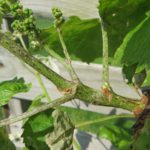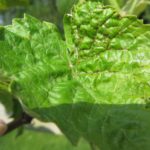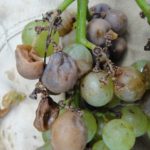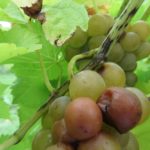The weather the past 3 weeks has been ideal for development of Phomopsis cane and leaf spot. Temperatures have been cool with frequent rain, and shoot growth has been slow. These conditions favor sporulation and infection by Phomopsis viticola. This pathogen is one of the major causes of fruit rot in the Midwest. Early season infections of shoots, cluster rachises and berry stems remain latent until veraison. Then as the fruit begins to ripen, the fungus resumes development and infects berries and girdles cluster stems. Damage can be severe and fruit quality greatly diminished. If a few sprays were missed and infections have occurred, infected shoots should be removed during shoot thinning to minimize problems later. As the weather gets warmer, new infections are less likely. But, any infected shoot can result in fruit rots later. Remove those during shoot thinning if possible.
I’ve had several emails about the best fungicide to apply during these rainy conditions. Mancozeb is our product of choice for Phomopsis, but it is a protectant fungicide that remains on the outside of the plant and must be present prior to infection. Even the “Rainfast” formulations, or those where a sticker was added will be washed off with heavy rain. The general rule of thumb is that about 1/2 of the residue is removed by 1 inch of rain. Two inches of rain means that most of the product was removed from the plant and reapplication is necessary. The very heavy rainfall we saw across the state this past 10 days has been a challenge for growers. Ideally we would apply a rainfast “systemic” fungicide during rainy periods. Unfortunately, the systemic sterol inhibitors (FRAC 3) we use for black rot and powdery mildew control are are not effective against Phomopsis. There are a couple of options for systemic fungicides: The FRAC 11 strobilurins (Abound, Flint, Luna Experience, Pristine, Quadris Top) are listed as ‘Fair’ for control of Phomopsis. Topsin-M, which is also systemic to a certain extent, provides ‘Good’ control. So those are a couple of options to consider. But don’t forget the role of sanitation. As mentioned above, removing any heavily infected shoots during shoot thinning makes a lot of sense. Fruit on those shoots is very likely to rot prior to harvest anyway.
- Phomopsis shoot and rachis infection
- Phomopsis leaf spot
- Phomopsis shoot infection
- Phomopsis rachis infection
- Phomopsis rachis infection and berry rot




